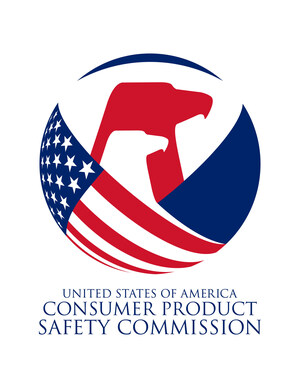CPSC Calls for Increased Water Safety Vigilance After Two Years of Pandemic Summers
WASHINGTON, June 9, 2022 /PRNewswire/ -- The annual drowning and submersion report released today by the U.S. Consumer Product Safety Commission (CPSC) shows fatal child drownings and nonfatal drowning injuries in children under age 15 remain high. CPSC urges families to make water safety a priority, particularly as children ages 5-14 return to community pools and summer camps, following two summers when COVID precautions kept kids away. Child drownings continue to be the leading cause of unintentional death among children ages 1 to 4 years old.
CPSC's latest data for the U.S. show:
- Across 2017 through 2019, there were an average of 389 pool- or spa-related, fatal drownings reported per year involving children younger than 15 years of age.
- Pool- or spa-related, hospital department-treated, nonfatal drowning injuries involving children younger than 15 years of age spiked 17 percent in 2021 with 6,800 injuries reported, compared to 2020 with 5,800.
- Of the reported pool- or spa-related fatal child drownings, seventy-three percent involved children younger than 5 years of age.
"Child drowning rates and nonfatal drowning injuries among children under 15 years old remain high, and water safety vigilance is as important as ever this summer for parents and caregivers," said CPSC Chair Alex Hoehn-Saric. "Whether a child is playing in a community pool, a neighbor's pool, or your own, we urge parents and caregivers to prepare their children for water-related activities by reviewing Pool Safely tips and signing up for swim lessons this summer. Working together, we can help reduce pool- and spa-related fatalities."
On average, from 2019 through 2021, 80 percent of children treated in emergency departments for pool- or spa-related, nonfatal drowning injuries were younger than 5 years of age. Where known, 73 percent of nonfatal incidents in children under age 5 that led to emergency room visits occurred at a residence, compared to nearly 27 percent that occurred in a public location. Two-thirds of reported fatal child drownings in pools or spas occurred in residential settings such as the victim's home, the house of a family member or friend, or a neighbor's residence.
Parents and caregivers can follow Pool Safely's simple steps to keep children safer in and around the water:
- Never leave a child unattended in or near water, and always designate an adult Water Watcher. This person should not be reading, texting, using a phone or be otherwise distracted. In addition to pools and spas, this warning includes bathtubs, buckets, decorative ponds, and fountains.
- If you own a pool or spa, install layers of barriers to prevent the unsupervised child from accessing the water. Homes can use door alarms, pool covers, and self-closing, self-latching devices on fence gates and doors that access pools.
- Learn how to perform CPR on children and adults. Many communities offer online CPR training.
- Learn how to swim and teach your child how to swim.
- Keep children away from pool drains, pipes and other openings to avoid entrapments.
- Ensure any pool and spa you use has drain covers that comply with federal safety standards and if you do not know, ask your pool service provider about safer drain covers.
- Visit the Pool Safely Kids' Corner to keep children entertained and educated with virtual water safety games and activities.
- Take the Pool Safely Pledge as a family, and find customized water safety resources using the Pool Safely Safer Water Information Match (S.W.I.M.) tool.
You can read the full CPSC drowning and entrapment reports by visiting PoolSafely.gov.
Note: CPSC's report addresses nonfatal drownings for the period 2019 through 2021 and fatal drownings for the period 2017 through 2019, reflecting a lag in the reporting of fatal drowning statistics.
Pool Safely, a national public education campaign supporting the requirements of Section 1407 of the Virginia Graeme Baker Pool and Spa Safety Act, works with collaborators around the country to reduce child drownings, nonfatal drownings and entrapment incidents in swimming pools and spas. Parents, caregivers and the media are encouraged to visit: PoolSafely.gov or to follow Pool Safely on Twitter, Facebook and Instagram for vital safety information regarding the prevention of child drownings in and around pools and spas.
For more information, contact Nikki Fleming in CPSC's Office of Communications at [email protected].
About the U.S. CPSC
The U.S. Consumer Product Safety Commission (CPSC) is charged with protecting the public from unreasonable risk of injury or death associated with the use of thousands of types of consumer products. Deaths, injuries, and property damage from consumer product-related incidents cost the nation more than $1 trillion annually. CPSC's work to ensure the safety of consumer products has contributed to a decline in the rate of injuries associated with consumer products over the past 50 years.
Federal law prohibits any person from selling products subject to a Commission ordered recall or a voluntary recall undertaken in consultation with the CPSC.
For lifesaving information:
- Visit CPSC.gov.
- Sign up to receive our e-mail alerts.
- Follow us on Facebook, Instagram @USCPSC and Twitter @USCPSC.
- Report a dangerous product or a product-related injury on www.SaferProducts.gov.
- Call CPSC's Hotline at 800-638-2772 (TTY 301-595-7054).
- Contact a media specialist.
Release Number: 22-149
SOURCE U.S. Consumer Product Safety Commission

WANT YOUR COMPANY'S NEWS FEATURED ON PRNEWSWIRE.COM?
Newsrooms &
Influencers
Digital Media
Outlets
Journalists
Opted In





Share this article